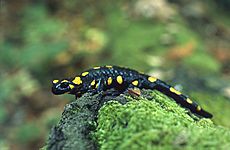Lissamphibians facts for kids
Quick facts for kids Lissamphibia |
|
|---|---|
 |
|
| The fire salamander | |
| Scientific classification | |
| Kingdom: | |
| Phylum: | |
| Subphylum: | |
| Superclass: | |
| Class: | |
| Subclass: |
Lissamphibia
Haeckel, 1866
|
| Orders | |
Lissamphibia is a special group of animals that includes all the living amphibians we see today. These amazing creatures are vertebrates, meaning they have a backbone, and they can live both on land and in water.
There are three main types, or "orders," of Lissamphibia:
- Anura: These are the frogs and toads. They are known for their strong jumping legs and loud calls.
- Caudata (or Urodela): This group includes salamanders and newts. They have long tails and usually walk on four legs.
- Gymnophiona (or Apoda): These are the caecilians. They look a bit like worms or snakes because they have no limbs (arms or legs).
Even though these three groups look very different, they all share some unique features. These shared traits suggest they all came from a common ancestor a very long time ago. This means they form a natural group, or "clade," in the animal kingdom.
Contents
What Makes Amphibians Special?
Lissamphibians have several unique features that set them apart from other animals. One of their most interesting traits is their skin. It is usually smooth and moist, and it helps them breathe! They can absorb oxygen directly through their skin, especially when they are in water.
Life Cycle and Metamorphosis
Most amphibians start their lives in water as larvae, like tadpoles. These larvae often have gills, which are special organs for breathing underwater, similar to fish. As they grow, they go through a big change called metamorphosis. During metamorphosis, they lose their gills and develop lungs, allowing them to breathe air. They also grow legs and change their body shape to live on land.
Where Do They Live?
Amphibians need moist environments to survive because of their special skin. You can find them in many different habitats around the world. They live in forests, wetlands, rivers, and even some deserts where there is enough moisture. They are often found near ponds, lakes, or streams.
The Three Main Groups of Lissamphibia
Let's take a closer look at the three fascinating groups that make up the Lissamphibia.
Frogs and Toads (Anura)
Frogs and toads are probably the most well-known amphibians. They are famous for their powerful hind legs, which are perfect for jumping and swimming. Most frogs have smooth, moist skin, while toads often have drier, bumpy skin. They are found all over the world, except in very cold places. Many frogs use their long, sticky tongues to catch insects.
Salamanders and Newts (Caudata)
Salamanders and newts look a bit like lizards, but they are amphibians. They have long bodies, four legs, and a tail that they keep throughout their lives. Many salamanders live in damp forests, hiding under logs or leaves. Newts are a type of salamander that often spend more time in water, especially during their breeding season. Some salamanders can even regrow lost limbs!
Caecilians (Gymnophiona)
Caecilians are the least known group of amphibians. They are limbless, meaning they don't have arms or legs, and they look like large worms or small snakes. Most caecilians live underground, burrowing through soil in tropical regions. They have small eyes, or sometimes no eyes at all, because they don't need to see much in their dark homes. They use special tentacles on their heads to help them find food.
Images for kids
See also
 In Spanish: Anfibios modernos para niños
In Spanish: Anfibios modernos para niños


